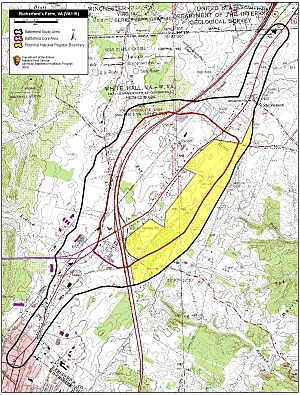Battle of Rutherford's Farm facts for kids
Quick facts for kids Battle of Rutherford's Farm |
|||||||
|---|---|---|---|---|---|---|---|
| Part of the American Civil War | |||||||
|
|||||||
| Belligerents | |||||||
| Commanders and leaders | |||||||
| William W. Averell | Stephen D. Ramseur | ||||||
| Strength | |||||||
| 2,350 | 3,300 | ||||||
| Casualties and losses | |||||||
| 220 total 36 killed 184 wounded |
450 total 200 killed and wounded 250 prisoners |
||||||
The Battle of Rutherford's Farm was a small but important fight during the American Civil War. It happened on July 20, 1864, in Frederick County, Virginia. This battle is also known as Carter's Farm or Stephenson's Depot.
The fight was between Confederate soldiers led by Major General Stephen Dodson Ramseur and Union soldiers led by Brigadier General William W. Averell. It was part of a larger plan by Confederate Lieutenant General Jubal Early to move his troops. The battle ended with a victory for the Union army.
During this battle, a brave soldier named John Shanes from the 14th West Virginia Infantry earned the Medal of Honor. He charged a Confederate cannon by himself and stopped it from firing.
Contents
Why the Battle Happened
After some smaller fights, Confederate General Early decided to move his army. He wanted to go from Berryville to a safer place called Strasburg. This move meant they had to empty their hospitals and supply areas in Winchester.
To protect this move, Early told Major General Ramseur to stay in Winchester. Ramseur's orders were clear: stay inside the city's defenses and avoid any unnecessary fights.
Meanwhile, Union Major General David Hunter heard a false report. He thought Confederate cavalry (soldiers on horseback) were in Winchester. He believed they were planning to attack the Baltimore and Ohio Railroad. To stop this, Hunter sent Brigadier General Averell's troops from Martinsburg. Averell moved slowly, being careful not to run into Early's main army. He camped at Bunker Hill by nightfall on July 19.
The Battle Begins
Ramseur's soldiers arrived in Winchester on the morning of July 20. He sent his cavalry, led by John C. Vaughn and William L. Jackson, to Carter's Farm. Their job was to scout and find the enemy.
Around 7 AM, Confederate scouts found the Union camp at Bunker Hill. They reported this to Ramseur. At 9 AM, Averell's Union force left their camp and moved down the Valley Turnpike. They fought with Confederate scouts the whole way.
By 11 AM, the Union soldiers reached Stephenson's Depot. There, they met Vaughn's and Jackson's dismounted cavalry. These Confederate soldiers had cannons on a small ridge. The cannons fired, stopping the Union advance. Averell brought up his own cannons, and a long artillery duel began.
Ramseur's Risky Move
Around 2 PM, Vaughn sent a message to Ramseur. He told Ramseur what was happening and suggested bringing in the infantry (foot soldiers) to surprise the Union force. Even though General Early had told him to stay in Winchester's defenses, Ramseur saw a chance for a big win. He agreed with Vaughn and sent his infantry to the battle.
Within an hour, the Confederate infantry arrived. They hid in a forest on top of the ridge. As they were getting into position, the Union attack began. When the Union soldiers got close to the woods, the hidden Confederates fired a huge volley of musket shots. This stopped the Union advance and almost broke their left side.
Union Victory
However, the woods where the Confederates were hiding stuck out towards the Union line. This left their left side exposed. Union cavalry quickly attacked this exposed Confederate left flank, causing it to break.
The Confederate center and right continued to fight hard. They fired many shots at the Union center and left. But slowly, one by one, the Confederate regiments on the left began to retreat towards Winchester. Finally, the entire Confederate line collapsed and ran away.
Ramseur tried his best to get his soldiers back in order. But they kept retreating until they reached the defenses of Winchester. Averell wasn't sure where the rest of Early's army was. So, he decided not to chase the retreating Confederates. This ended the battle.
What Happened Next
The Battle of Rutherford's Farm was a clear Union victory. It didn't change the overall war plans much. But it gave the Union soldiers a much-needed boost in morale. They had been losing many battles to Early's experienced troops.
The evacuation of Winchester continued without problems. Ramseur had disobeyed orders and lost soldiers. But General Early only gave him a stern talking-to.
Pvt. John Shanes from the 14th West Virginia Infantry was awarded the Medal of Honor for his bravery. He "charged upon a Confederate fieldpiece in advance of his comrades and by his individual exertions silenced the piece."
Today, the battlefield area has changed a lot. It is now on the north side of Winchester, Virginia. A shopping center and office complex stand where the battle once took place.


